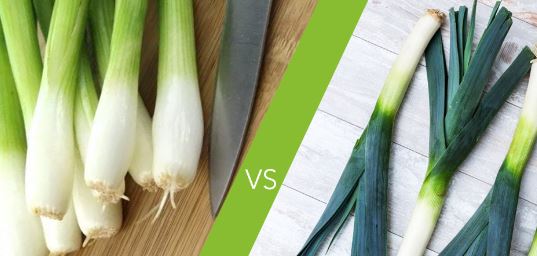Scallion vs. Leek: Understanding the Differences and Best Uses
Scallions and leeks are two popular vegetables used in various culinary dishes. While they may seem similar at first glance, they possess distinct characteristics and flavors that set them apart. In this article, we will delve into the world of scallions and leeks, exploring their differences, unique qualities, and ideal culinary applications. By understanding the distinctions between these two ingredients, you can elevate your cooking and make informed choices when it comes to adding depth and flavor to your dishes.

Scallion vs leek
I. Scallions: Versatile Green Onions
1. Overview and Appearance: Scallions, also known as green onions, are young onions harvested before they develop a bulb. They have long, slender green leaves and white bulbs with mild onion flavor.
2. Flavor Profile and Culinary Uses: Scallions offer a delicate and subtle onion flavor with a hint of mild garlic. They are commonly used as a garnish, added raw to salads, salsas, and dressings. Scallions also add freshness to stir-fries, soups, and omelets. They can be used as a milder substitute for onions when a less pronounced flavor is desired.
II. Leeks: The Elegant Alliums
1. Overview and Appearance: Leeks are members of the onion family and have a cylindrical shape with long, slender green leaves and a white bulb. They are known for their distinctive layered structure.
2. Flavor Profile and Culinary Uses: Leeks offer a subtle and slightly sweet onion flavor with a mild earthiness. They are commonly used in soups, stews, and braised dishes, where their flavor becomes more pronounced. Leeks can be sautéed, grilled, or used as a flavor-enhancing ingredient in stocks and broths. Their milder taste makes them a versatile option in recipes that require a gentler onion flavor.
III. Key Differences and How to Use Them
1. Texture and Appearance: Scallions have a slender and straight shape with long green leaves and a small white bulb. Leeks, on the other hand, have a cylindrical shape with broader leaves and a larger white bulb.
2. Flavor Intensity: Scallions offer a milder and more subtle flavor compared to leeks. Leeks have a stronger, sweeter taste with earthy undertones.
3. Culinary Applications: Scallions are often used raw or lightly cooked to add a hint of freshness and crunch to dishes. They work well in salads, garnishes, and as a topping for grilled meats and vegetables. Leeks, on the other hand, shine when cooked, particularly in soups, stews, and dishes where their flavor can meld with other ingredients.
IV. Recipe Inspiration:
Scallion and Leek Recipes
1. Scallion Recipes:
- Scallion Pancakes: A popular Asian dish that combines scallions with a savory pancake batter.
- Scallion and Ginger Sauce: A versatile condiment perfect for dipping dumplings, seafood, or roasted meats.
2. Leek Recipes:
- Potato Leek Soup: A classic creamy soup that showcases the delicate flavor of leeks.
- Leek and Mushroom Quiche: A flavorful and hearty dish that combines leeks, mushrooms, and cheese in a savory pastry crust.

Big leek
While scallions and leeks may share some similarities, understanding their unique characteristics and best culinary uses allows you to maximize their flavors in your cooking. Scallions bring a mild and refreshing touch to various dishes, while leeks offer a more pronounced and versatile taste when cooked. By incorporating these ingredients mindfully, you can enhance the depth and complexity of your recipes. So, whether you're adding scallions to brighten up a salad or simmering leeks in a comforting soup, embrace the distinct qualities of each and enjoy the flavorful journey they offer in your culinary creations.